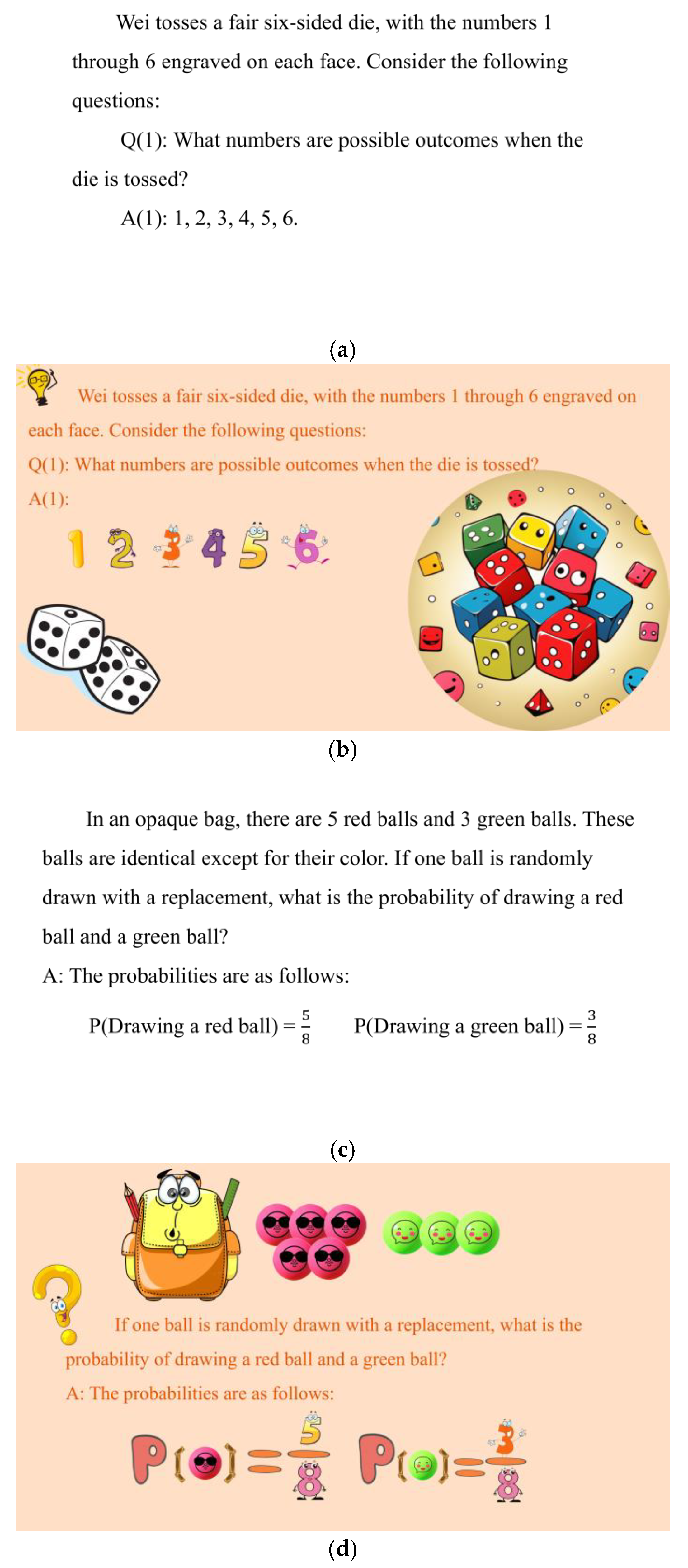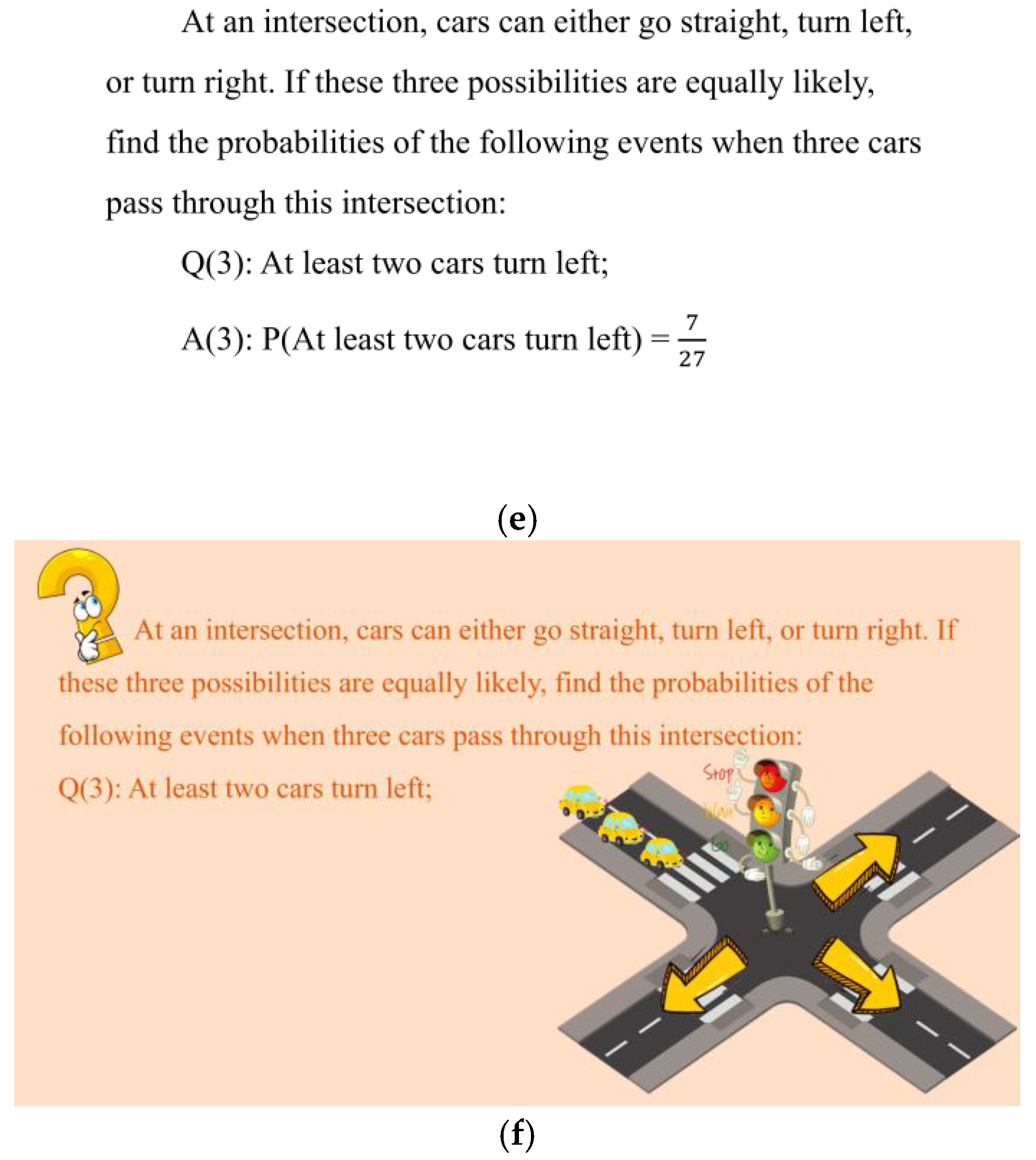The Impact of Emotional Design on Multimedia Learning Outcomes: The Moderating Role of Task Difficulty
Abstract
1. Introduction
1.1. Effects of Emotional Design on Multimedia Learning Outcomes
1.2. Task Difficulty, Emotional Design, and Multimedia Learning Outcomes
1.3. The Present Study and Hypotheses
2. Materials and Methods
2.1. Participants and Design
2.2. Design of Materials
“A fair six-sided die has numbers 1 through 6 on its faces. What are the possible outcomes when the die is tossed?”(Answer: random event, 1, 2, 3, 4, 5, 6.)
“A bag contains 5 red balls and 3 green balls. One ball is randomly drawn, with a replacement. What is the probability of drawing one red ball and one green ball in two draws?”(Answer: the probability of drawing a red ball is 5/8, and drawing a green ball is 3/8.)
“At an intersection, three cars can either go straight, turn left, or turn right. If these three possibilities are equally likely, what is the probability that at least two cars will turn left?”(Answer: the probability is 7/27.)
2.3. Measures
2.4. Procedure
3. Results
3.1. Task Difficulty
3.2. Positive Emotions
3.3. Learning Outcomes
4. Discussion
5. Conclusions
Supplementary Materials
Author Contributions
Funding
Institutional Review Board Statement
Informed Consent Statement
Data Availability Statement
Acknowledgments
Conflicts of Interest
References
- Brom, C., Stárková, T., & D’Mello, S. K. (2018). How effective is emotional design? A meta-analysis on facial anthropomorphisms and pleasant colors during multimedia learning. Educational Research Review, 25, 100–119. [Google Scholar] [CrossRef]
- Bülbül, A. H., & Kuzu, A. (2021). Emotional design of educational animations: Effects on emotion, learning, motivation and interest. Participatory Educational Research, 8(3), 3. [Google Scholar] [CrossRef]
- Chiu, T. K. F., Jong, M. S., & Mok, I. A. C. (2020). Does learner expertise matter when designing emotional multimedia for learners of primary school mathematics? Educational Technology Research and Development, 68(5), 2305–2320. [Google Scholar] [CrossRef]
- Gong, S., Shangguan, C., Zhai, K., & Guo, Y. (2017). The effects of emotional design on multimedia learning. Acta Psychologica Sinica, 49(6), 771. [Google Scholar] [CrossRef]
- Heidig, S., Müller, J., & Reichelt, M. (2015). Emotional design in multimedia learning: Differentiation on relevant design features and their effects on emotions and learning. Computers in Human Behavior, 44, 81–95. [Google Scholar] [CrossRef]
- Horovitz, T., & Mayer, R. E. (2021). Learning with human and virtual instructors who display happy or bored emotions in video lectures. Computers in Human Behavior, 119, 106724. [Google Scholar] [CrossRef]
- Javora, O., Hannemann, T., Stárková, T., Volná, K., & Brom, C. (2019). Children like it more but don’t learn more: Effects of esthetic visual design in educational games. British Journal of Educational Technology, 50(4), 1942–1960. [Google Scholar] [CrossRef]
- Johnson, A. M., Ozogul, G., & Reisslein, M. (2015). Supporting multimedia learning with visual signalling and animated pedagogical agent: Moderating effects of prior knowledge. Journal of Computer Assisted Learning, 31(2), 97–115. [Google Scholar] [CrossRef]
- Kalyuga, S. (2011). Cognitive load theory: How many types of load does it really need? Educational Psychology Review, 23(1), 1–19. [Google Scholar] [CrossRef]
- Kalyuga, S., Chandler, P., & Sweller, J. (2000). Incorporating learner experience into the design of multimedia instruction. Journal of Educational Psychology, 92(1), 126–136. [Google Scholar] [CrossRef]
- Knörzer, L., Brünken, R., & Park, B. (2016). Emotions and multimedia learning: The moderating role of learner characteristics: Emotions in multimedia learning. Journal of Computer Assisted Learning, 32(6), 618–631. [Google Scholar] [CrossRef]
- Krieglstein, F., Beege, M., Rey, G. D., Ginns, P., Krell, M., & Schneider, S. (2022). A systematic meta-analysis of the reliability and validity of subjective cognitive load questionnaires in experimental multimedia learning research. Educational Psychology Review, 34(4), 2485–2541. [Google Scholar] [CrossRef]
- Le, Y., Chen, Z., Liu, S., Pang, W., & Deng, C. (2021). Investigating the effectiveness of emotional design principle to attenuate ego depletion effect. Computers & Education, 174, 104311. [Google Scholar] [CrossRef]
- Le, Y., Liu, J., Deng, C., & Dai, D. Y. (2018). Heart rate variability reflects the effects of emotional design principle on mental effort in multimedia learning. Computers in Human Behavior, 89, 40–47. [Google Scholar] [CrossRef]
- Mayer, R. E. (2005). Cognitive theory of multimedia learning. In The Cambridge handbook of multimedia learning (2nd ed.). Cambridge University Press. [Google Scholar]
- Mayer, R. E. (2017). Using multimedia for e-learning. Journal of Computer Assisted Learning, 33(5), 403–423. [Google Scholar] [CrossRef]
- Mayer, R. E., & Estrella, G. (2014). Benefits of emotional design in multimedia instruction. Learning and Instruction, 33, 12–18. [Google Scholar] [CrossRef]
- Moreno, R., & Mayer, R. (2007). Interactive multimodal learning environments: Special issue on interactive learning environments: Contemporary issues and trends. Educational Psychology Review, 19(3), 309–326. [Google Scholar] [CrossRef]
- Plass, J. L., Heidig, S., Hayward, E. O., Homer, B. D., & Um, E. (2014). Emotional design in multimedia learning: Effects of shape and color on affect and learning. Learning and Instruction, 29, 128–140. [Google Scholar] [CrossRef]
- Plass, J. L., & Kaplan, U. (2016). Emotional design in digital media for learning. In Emotions, technology, design, and learning (pp. 131–161). Elsevier. [Google Scholar] [CrossRef]
- Schneider, S., Nebel, S., Meyer, S., & Rey, G. D. (2022). The interdependency of perceived task difficulty and the choice effect when learning with multimedia materials. Journal of Educational Psychology, 114(3), 443–461. [Google Scholar] [CrossRef]
- Shangguan, C., Gong, S., Guo, Y., Wang, X., & Lu, J. (2020). The effects of emotional design on middle school students’ multimedia learning: The role of learners’ prior knowledge. Educational Psychology, 40(9), 1076–1093. [Google Scholar] [CrossRef]
- Stárková, T., Lukavský, J., Javora, O., & Brom, C. (2019). Anthropomorphisms in multimedia learning: Attract attention but do not enhance learning? Journal of Computer Assisted Learning, 35(4), 555–568. [Google Scholar] [CrossRef]
- Sweller, J. (2020). Cognitive load theory and educational technology. Educational Technology Research and Development, 68(1), 1–16. [Google Scholar] [CrossRef]
- Um, E., Plass, J. L., Hayward, E. O., & Homer, B. D. (2012). Emotional design in multimedia learning. Journal of Educational Psychology, 104(2), 485–498. [Google Scholar] [CrossRef]
- Uzun, A. M., & Yıldırım, Z. (2018). Exploring the effect of using different levels of emotional design features in multimedia science learning. Computers & Education, 119, 112–128. [Google Scholar] [CrossRef]
- Wang, J., Antonenko, P., & Dawson, K. (2020). Does visual attention to the instructor in online video affect learning and learner perceptions? An eye-tracking analysis. Computers & Education, 146, 103779. [Google Scholar] [CrossRef]
- Wang, X., Mayer, R. E., Han, M., & Zhang, L. (2023). Two emotional design features are more effective than one in multimedia learning. Journal of Educational Computing Research, 60(8), 1991–2014. [Google Scholar] [CrossRef]
- Watson, D., Clark, L. A., & Tellegen, A. (1988). Development and validation of brief measures of positive and negative affect: The PANAS scales. Journal of Personality and Social Psychology, 54(6), 1063–1070. [Google Scholar] [CrossRef]
- Wong, R. M., & Adesope, O. O. (2021). Meta-analysis of emotional designs in multimedia learning: A replication and extension study. Educational Psychology Review, 33(2), 357–385. [Google Scholar] [CrossRef]



| NL | EL | NM | EM | NH | EH | |
|---|---|---|---|---|---|---|
| Task difficulty | 2.13 (1.38) | 2.70 (1.39) | 4.43 (2.01) | 4.63 (2.09) | 6.60 (1.79) | 6.13 (1.48) |
| Positive emotions | 2.67 (0.77) | 3.58 (0.95) | 2.94 (0.50) | 3.57 (0.79) | 2.64 (0.63) | 3.61 (0.65) |
| Learning outcomes | 11.87 (1.28) | 12.17 (1.18) | 7.80 (2.25) | 9.77 (1.78) | 3.27 (2.03) | 3.50 (2.33) |
Disclaimer/Publisher’s Note: The statements, opinions and data contained in all publications are solely those of the individual author(s) and contributor(s) and not of MDPI and/or the editor(s). MDPI and/or the editor(s) disclaim responsibility for any injury to people or property resulting from any ideas, methods, instructions or products referred to in the content. |
© 2025 by the authors. Licensee MDPI, Basel, Switzerland. This article is an open access article distributed under the terms and conditions of the Creative Commons Attribution (CC BY) license (https://creativecommons.org/licenses/by/4.0/).
Share and Cite
Liu, Z.; Wang, Z. The Impact of Emotional Design on Multimedia Learning Outcomes: The Moderating Role of Task Difficulty. Behav. Sci. 2025, 15, 397. https://doi.org/10.3390/bs15030397
Liu Z, Wang Z. The Impact of Emotional Design on Multimedia Learning Outcomes: The Moderating Role of Task Difficulty. Behavioral Sciences. 2025; 15(3):397. https://doi.org/10.3390/bs15030397
Chicago/Turabian StyleLiu, Zhihong, and Zhenhong Wang. 2025. "The Impact of Emotional Design on Multimedia Learning Outcomes: The Moderating Role of Task Difficulty" Behavioral Sciences 15, no. 3: 397. https://doi.org/10.3390/bs15030397
APA StyleLiu, Z., & Wang, Z. (2025). The Impact of Emotional Design on Multimedia Learning Outcomes: The Moderating Role of Task Difficulty. Behavioral Sciences, 15(3), 397. https://doi.org/10.3390/bs15030397





